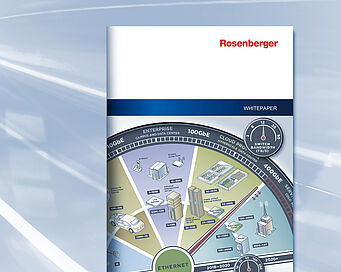Fiber optic cabling has already started its triumphant advance
If one compares the development of data transmission with that in rail traffic, the comparison between the steam locomotive in the past and the high-speed train today becomes obvious. In the past, data was transmitted via copper cables, a proven technology that is still in use today. The disadvantage: copper has a resistance. As a result, the signals become weaker and weaker after a certain distance. With the increasing length of the lines, the speeds that can be achieved during data transmission decrease. Fiber optics, on the other hand, use light pulses for data transmission. These are hardly weakening even over long distances. The result is much higher transfer rates.
For the "Internet of Things" (IoT) or other solutions, such as autonomous driving or smart city applications and much more, fast Internet connections are essential. This also applies to private applications, such as smart home equipment in residential buildings. Therefore, optical connections are recommended to ensure faultless operation and delay-free data transmission.
Agenda between desire and reality
In its digital agenda, the German government already decided in 2014, to expand nationwide with high-performance networks. This should benefit not only private households but also the economy. So far, however, the federal government has had a hard time implementing the plan. The target of supplying fiber optics by the end of the last legislative period was not achieved. The overriding goal of a super-fast Internet with at least 50 Mbit/s throughout Germany by 2018 will probably remain a dream of the future for a while. And experts also see the coming years as black. According to the Bertelsmann Foundation, Germany is only 15th in Europe in terms of average transmission rates (30 Mbit/s), but transmission rates of up to 1,000 Mbit/s require more optical fiber than has been installed to date. In an international comparison, Germany currently ranks only at the bottom.
The public does not accept the sluggish expansion of the German fiber optic network. For example, the citizens' initiative PRO Glasfaser was founded some time ago. It bundles the nationwide demand for fiber optic connections and puts pressure on politcs. The aim is to rapidly promote the sustainable expansion of broadband across the country and to replace copper-based connection types in the medium term. The aim is fiber-to-the-home cabling throughout the building and into every flat.
Optical cabling requires specific know-how
Fiber optic cabling has already started its triumphant advance in the corporate environment, in the cabling of company premises, building complexes or data centers. This is especially true when longer distances need to be bridged. In the age of cloud computing and Hyperscale data centers, data traffic is growing dramatically. According to market analysts, volumes in the double-digit Zetabyte range can already be expected in about three years. This can only be achieved via fiber optic infrastructures.
However, the optical technology is complex and cannot be compared with the copper cabling used up to now. Fiber optic requires specific technological knowledge, not only of the technology itself, but also of standards, modes of operation and various accompanying circumstances. Examples are singlemode and multimode, wavelengths, refraction and return or attenuation and refractive index. Targeted training and continuous education of competent technicians is therefore a success criterion for fiber optic projects. Because the installation, operation and last but not least the maintenance of fiber optic cabling infrastructures requires trained personnel who always work at the latest technological level. This applies to data centers as well as to companies and the private environment.





